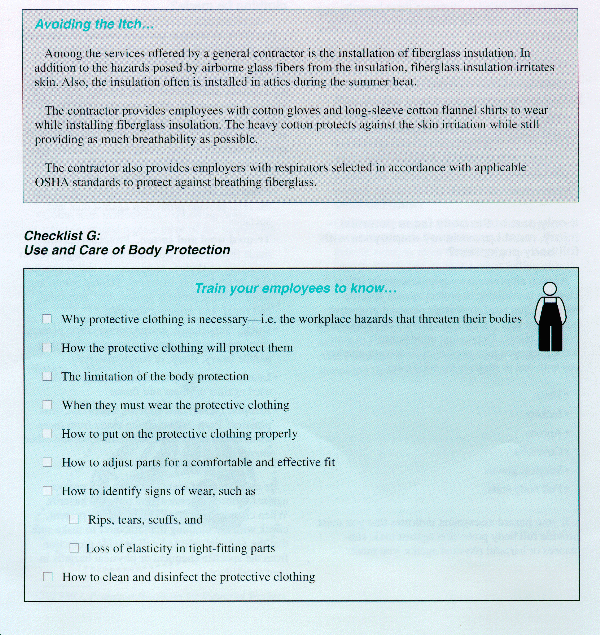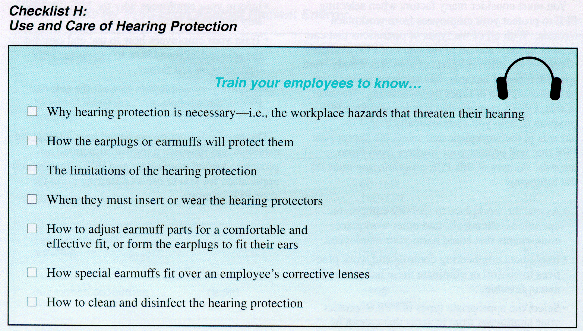
 Assessing the Need
Assessing the Need
for Personal Protective Equipment:
A Guide for Small Business Employers
Small Business Safety Management Series
U.S. Department of Labor
Occupational Safety and Health Administration
OSHA 3151
1997
When must I provide my employees with full body protection?
You must provide body protection for employees if they are threatened with bodily injury of one kind or another while performing their jobs, and if engineering, work practice, and administrative controls have failed to eliminate these hazards. Workplace hazards that could cause bodily injury include the following:
Intense heat
Splashes of hot metals and other hot liquids
Impacts from tools, machinery, and materials
Cuts
Hazardous chemicals
Contact with potentially infectious materials, like blood
Radiation.
As with all protective equipment, protective clothing is available to protect against specific hazards. You need to provide personal protective equipment only for the parts of the body exposed to possible injury. Depending upon hazards in your workplace, you may need to provide your employees with one or more of the following:
Vests
Jackets
Aprons
Coveralls
Surgical gowns
Full body suits.
If your hazard assessment indicates that you must provide full body protection against toxic substances or harmful physical agents, you must:
Inspect the clothing carefully,
Ensure proper fit, and
Make sure the protective clothing functions properly.
From what material should protective clothing be made?
Protective clothing comes in a variety of materials, each suited to particular hazards. Conduct your hazard assessment. Identify the sources of any possible bodily injury. Install any feasible engineering controls, and institute work practice controls to eliminate the hazards. If the possibility of bodily injury still exists, provide protective clothing constructed of material that will protect against the specific hazards in your workplace. Materials for protective clothing include the following:
Paperlike fiber. Disposable suits made of this material provide protection against dust and splashes.
Treated wool and cotton. Protective clothing made from treated wool and cotton adapts well to changing workplace temperatures and is comfortable as well as fire resistant. Treated cotton and wool clothing protects against dust, abrasions, and rough and irritating surfaces.
Duck. This closely woven cotton fabric protects employees against cuts and bruises while they handle heavy, sharp, or rough materials.
Leather. Leather protective clothing is often used against dry heat and flame.
Rubber, rubberized fabrics, neoprene, and plastics. Protective clothing made from these materials protects against certain acids and other chemicals.
Be aware that different materials will protect against different chemical and physical hazards. When chemical or physical hazards are present, check with the clothing manufacturer to make sure that the material selected will provide protection from the specific chemical or physical hazards in your workplace.
How do I make sure employees properly use the body protection I provide?
Train your employees to use the protective clothing. Checklist G will help
you instruct
them in the use and care of the body protection.

When must I provide hearing protection for my employees?
Determining the need to provide hearing protection can be tricky. Employee exposure to excessive noise depends upon a number of factors:
Generally, the louder the noise, the shorter the exposure time before you must provide hearing protection. For instance, employees may be exposed to a noise level of 90 dBA for 8 hours per day before you must provide hearing protection for them. Suppose, however, that the noise level reaches 115 dBA in your workplace. Then you must provide hearing protection if their anticipated exposure exceeds 15 minutes.
Table 5 shows when you must provide hearing protection to employees exposed to occupational noise at specific levels for specific periods. Noises are considered continuous if the interval between occurrences of the maximum noise level is 1 second or less. Noises not meeting this definition are considered impact or impulse noises. Exposure to impact or impulse noises (loud momentary explosions of sound) must not exceed 140 dB. Examples of impact or impulse noises may include the noise from a powder-actuated nail gun, the noise from a punch press, or the noise from drop hammers.
For more information on noise, consult Chapter II:5, "Noise Measurement," of
the OSHA
Technical Manual.(10)

Will earplugs reduce employee exposure to high noise levels?
As with other types of hazards, you must implement feasible engineering controls and work practices before resorting to PPE such as earplugs or earmuffs. If engineering and work practice controls do not lower employee exposure to workplace noise to acceptable levels, then you must provide employees with appropriate PPE.
What if my employees are exposed to different levels of noise throughout the day?
If employees move from location to location and the noise level is different in each location, or if the noise levels in an area change throughout the day (e.g., equipment turns on or off), you must calculate an "equivalent noise factor" to determine whether you must provide hearing protection.
Measure the noise level at each location in which the employee works.
For each noise level, find the allowable duration in Table 5.
For each location, divide the actual time the employee spends there by the permissible duration for the noise at the measured level, according to Table 5.
Add all the results from your division.
If the total is greater than one, you must implement engineering controls or work practices or provide hearing protection to your exposed employees.
The formula for calculating this exposure is as follows:

What kinds of devices protect against high noise levels? Is cotton sufficient as earplugs?
Plain. cotton does not effectively protect against occupational noise. You may, however, choose from several products that are effective at protecting your employees' hearing.
Single-use earplugs. Made of waxed cotton, foam, or fiberglass wool, these ear plugs are self-forming and, when properly inserted, work as well as most molded earplugs.
Preformed or molded earplugs. Sometimes single use and disposable, these plugs must be individually fitted by a professional. Nondisposable plugs should be cleaned after each use.
Earmuffs. Earmuffs require a perfect seal around the ear. Glasses, long sideburns, long hair, and facial movements such as chewing may reduce the protective value of earmuffs. You may purchase special earmuffs designed for use with eyeglasses or beards.
If I provide my employees with hearing protection, can they then work in areas with any level of noise for any period of time?
No. Hearing protectors reduce only the amount of noise that gets through to the ears. The amount of this reduction is referred to as attenuation. Attenuation differs according to the type of hearing protection used and how well they fit. The hearing protectors you choose must be capable of achieving the attenuation needed to reduce the employee's noise exposure to within the acceptable limits noted in Table 5. Appendix B of 29 CFR 1910.95, Occupational Noise Exposure, describes methods for estimating the attenuation of a particular hearing protector based on the device's noise reduction rating (NRR). Manufacturers of hearing protection devices must report the device's NRRs on the product packaging.
Train your employees to use the hearing protection. Checklist H will help you train your employees to use and care for the earplugs or earmuffs that you provide.

If your employees are exposed to occupational noise at or above 85 dBA averaged over an 8-hour period, then you must institute a hearing conservation program that includes regular testing of employees' hearing by qualified professionals. The OSHA occupational noise standard, at 29 CFR 1910.95, sets forth the requirements for a hearing conservation program.
You must consider many factors when selecting PPE to protect your employees from workplace hazards. With all of the types of operations that can present hazards and all of the types of PPE available to protect the different parts of a worker's body from specific types of hazards, this selection process can be confusing and at times overwhelming. Because of this, OSHA requires that you implement a PPE program to help you systematically assess the hazards in the workplace and select the appropriate PPE that will protect your workers from those hazards. As part of this PPE program, you must do the following:
Assess the workplace to identify equipment, operations, chemicals, and other workplace components that could harm your employees.
Implement engineering controls and work practices to control or eliminate these hazards to the extent feasible.
Select the appropriate types of PPE to protect your employees from hazards that cannot be eliminated or controlled through engineering controls and work practices.
Inform your employees why the PPE is necessary and when it must be worn.
Train your employees how to use and care for the selected PPE and how to recognize PPE deterioration and failure.
Require your employees to wear the selected PPE in the workplace.
The basic information presented here attempts to establish and illustrate a logical, structured approach to hazard assessment and PPE selection and application for you to use as a starting point for your PPE program.
This manual is online: http://www.osha.gov